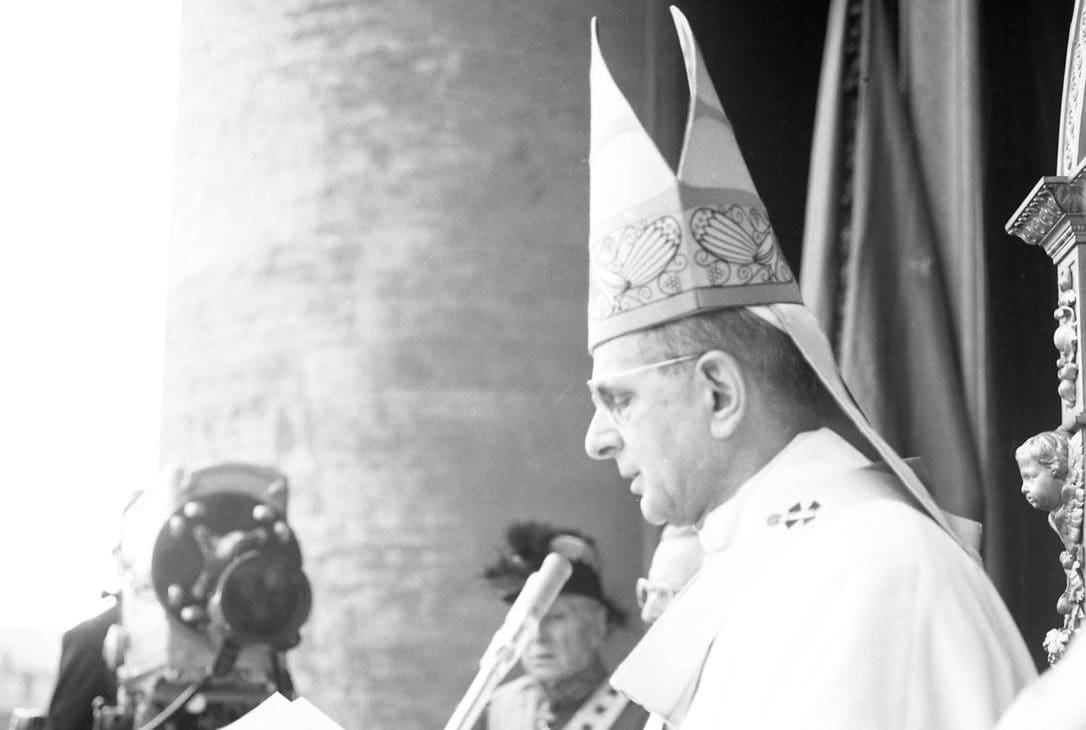Address to a Wednesday General Audience, November 19, 1969
Beloved Sons and Daughters!
We wish to draw your attention to an event that is about to take place in the Latin Rite of the Catholic Church, something that will be required in the dioceses of Italy beginning with the First Sunday of Advent, which this year [1969] falls on November 30: that is, the introduction into the Liturgy of the new rite of the Mass. The Mass will be celebrated in a form somewhat different from that to which we have been accustomed since the time of the Council of Trent and St. Pius V, four centuries ago.
The change is somewhat surprising, extraordinary, since the Mass is regarded as a traditional and untouchable expression of our religious worship and of the authenticity of our faith. We may ask ourselves: How could such a change ever come about? And what is the nature of the change? What consequences will it have for those who assist at Holy Mass? The answers to these and other questions stirred up by such a singular novelty will be shared and widely repeated in all the churches, all the religious publications, and all the schools in which Christian doctrine is taught. We exhort you to pay close attention, seeking to reach a greater clarity and depth in understanding the stupendous and mysterious reality of the Mass.
In the meantime, with this brief and elementary discourse we will seek to resolve the initial, spontaneous difficulties that are prompted in your minds by such a change, in relation to three questions that it has caused to arise in our spirits.
Why a change in the rite of the Mass?
Whatever can be the reason for such a change? Response: It is the express will of the Ecumenical Council just celebrated. In the words of the Council:
“The rite of the Mass is to be revised in such a way that the intrinsic nature and purpose of its several parts, as also the connection between them, may be more clearly manifested, and that devout and active participation by the faithful may be more easily achieved.
“For this purpose the rites are to be simplified, due care being taken to preserve their substance; elements which, with the passage of time, came to be duplicated, or were added with but little advantage, are now to be discarded; other elements which have suffered injury through accidents of history are now to be restored to the vigor which they had in the days of the holy Fathers, as may seem useful or necessary”(Sacrosanctum Concilium, 50).
What in the Mass has Changed?
Another question: In what does the change consist? You will see that it consists in many new ritual instructions which will require, especially in the beginning, a certain amount of attention and care. Personal devotion and a communal sense will make these instructions easy and pleasing to observe. But let us be clear: nothing has changed in the substance of our traditional Mass. Someone might be upset by a certain ceremony, or an attached rubric, as if it were—or as if it concealed—an alteration or a weakening of perennial and authoritatively sanctioned truths of the Catholic Faith; almost as if the equation between the law of prayer, lex orandi, and the law of faith, lex credendi, were compromised.
But it is not so. Absolutely not. First of all because a rite and its associated rubrics do not belong per se to the category of a dogmatic definition, but rather can vary in their theological standing according to the liturgical context to which they refer; these words and gestures refer to a lived religious action, one which springs from an ineffable mystery of the Divine presence which is not always realized in an univocal form. This religious action can be analyzed and expressed in logically satisfying doctrinal formulas only by means of a theological critique. Furthermore, the Mass of the new order is and remains—if anything more strongly evident in certain respects—the perennial Mass. The unity between the Lord’s Supper and the sacrifice of the cross, and the re-presentation of the one and of the other in the Mass, is inviolably affirmed and celebrated in the new order as in the preceding one. The Mass is and remains the memorial of Christ’s Last Supper in which the Lord, transforming the bread and wine into his Body and Blood, instituted the sacrifice of the new Testament and willed that that sacrifice— through the power of his Priesthood conferred on the Apostles—be renewed in its identity, but offered in an unbloody and sacramental way, in perennial memory of him, until his final coming (cfr. DE LA TAILLE, Mysterium Fidei, Elucid. IX).
If in the new rite you find more clearly placed the relationship between the Liturgy of the Word and the Eucharistic Liturgy proper—the latter being in a sense the fulfillment of the former (cfr. BOUYER)—or if you observe the degree to which the celebration of the Eucharistic sacrifice reclaims the participation of the assembled faithful, who in the Mass are and fully experience themselves as “Church,” or if you see expressed other marvelous characteristics of our Mass, do not think that this is intended to alter its genuine and traditional essence. Appreciate, rather, the way in which, through this new and diffuse language, the Church wishes to render her liturgical message more effective and to draw near to each of her children and to the whole People of God in a more direct and pastoral manner.
How will this goal be realized in practice?
Finally, let us respond to the third question we have posed: What consequences will result from the innovation about which we have been deliberating? The consequences foreseen, or better, desired, are those of a more intelligent, practical, joyful and sanctifying participation of the faithful in the liturgical mystery—that is, in the hearing of the Word of God, alive and resonant through the centuries and in the unfolding story of each individual soul, and in the mystical reality of the sacramental and redeeming sacrifice of Christ.
Let us not, then, refer to it as the “new Mass,” but rather as a “new era” in the life of the Church. With our Apostolic Blessing.
The original text of Paul VI’s Wednesday audience appears in Italian on the Vatican website. Translation provided by Christopher Ruff for Adoremus.


